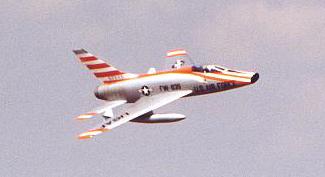|
 

Yaw Stability Augmentation
The BobCat
uses a gyro
  The design of any airplane, large or small, entails compromises to
achieve a variety of desired performance characteristics. The design of any airplane, large or small, entails compromises to
achieve a variety of desired performance characteristics.
   The fact that modern fighters like the F-16 or F-18 can accomplish
multi task, air to air and air to ground missions, means that some compromises
had to be made. The fact that modern fighters like the F-16 or F-18 can accomplish
multi task, air to air and air to ground missions, means that some compromises
had to be made.
  One of the
design goals of the BobCat was to minimize the number of control surfaces that
had to be constructed, hinged, rigged and thoughtfully operated. One of the
design goals of the BobCat was to minimize the number of control surfaces that
had to be constructed, hinged, rigged and thoughtfully operated.
  To eliminate the need for a separate speed
brake or flap system, we oriented the landing gear to activate into the
relative wind. This allowed a very simple landing gear door system (laser cut
panels bolt to the retract unit) to provide enough drag to offset the engine
thrust at idle. To eliminate the need for a separate speed
brake or flap system, we oriented the landing gear to activate into the
relative wind. This allowed a very simple landing gear door system (laser cut
panels bolt to the retract unit) to provide enough drag to offset the engine
thrust at idle.
  Because
these doors (air brakes), in the extended position have a moment about the
vertical axis of the model, the slightest "upset" can cause some
yawing. Because
these doors (air brakes), in the extended position have a moment about the
vertical axis of the model, the slightest "upset" can cause some
yawing.
Gyros and
Jet Models
   Adjustable
gain piezo electric gyros are one of the benefits of today's technology, so why
not use them. Every swept wing jet can experience what is termed Dutch Roll. A
gyro on the rudder will totally dampen this effect and make you and your model
look great. Adjustable
gain piezo electric gyros are one of the benefits of today's technology, so why
not use them. Every swept wing jet can experience what is termed Dutch Roll. A
gyro on the rudder will totally dampen this effect and make you and your model
look great.
  The popular flying wing
designs also look better when gyro stabilized. The popular flying wing
designs also look better when gyro stabilized.
  Variable rate (gain control) gyros to compensate for yaw are
absolutely a part of the jet modeling experience. Our scale F-4, F-100 and
Rafale utilize them. So, it is not a bad thing to introduce a new jet jockey to
their use should he get started with a BobCat. Variable rate (gain control) gyros to compensate for yaw are
absolutely a part of the jet modeling experience. Our scale F-4, F-100 and
Rafale utilize them. So, it is not a bad thing to introduce a new jet jockey to
their use should he get started with a BobCat.
How to set it up
  First, we recommend using a top-of-the-line unit like the JR 450. We
tried one of the less expensive types but it did not provide sufficient rate
change or accuracy. First, we recommend using a top-of-the-line unit like the JR 450. We
tried one of the less expensive types but it did not provide sufficient rate
change or accuracy.
  Next, be
sure to read the instructions that accompany the unit and be absolutely
positive that the reverse switch is in the correct position. Move the model's
nose "left", the rudder should deflect "right". Next, be
sure to read the instructions that accompany the unit and be absolutely
positive that the reverse switch is in the correct position. Move the model's
nose "left", the rudder should deflect "right".
  A "y" harness connecting the gyro to the nose gear steering servo
can also reduce your work load on take-off. Our factory BobCats however, do not
use this feature, but some more narrow stance models like a Sabre Jet can
benefit with this application. A "y" harness connecting the gyro to the nose gear steering servo
can also reduce your work load on take-off. Our factory BobCats however, do not
use this feature, but some more narrow stance models like a Sabre Jet can
benefit with this application.
  Now, use your "trick transmitter" to slave the gyro gain channel to
activate with the gear switch. Adjust the gyro gain (on a BobCat) to about 40%
activity for gear up and about 80% for gear down. The servo monitor feature on
the JR transmitter is handy to view these settings. Now, use your "trick transmitter" to slave the gyro gain channel to
activate with the gear switch. Adjust the gyro gain (on a BobCat) to about 40%
activity for gear up and about 80% for gear down. The servo monitor feature on
the JR transmitter is handy to view these settings.
  Flight testing will allow you to fine tune these settings, then you
can deactivate the gyro gain channel dial and forget about it. Flight testing will allow you to fine tune these settings, then you
can deactivate the gyro gain channel dial and forget about it.
  Note that windy days may require more "gain"
adjustment to smooth things out. Note that windy days may require more "gain"
adjustment to smooth things out.
The Economics
A JR 460T gyro sells for about $160.00.
To activate a separate speed brake, a very powerful servo or an air cylinder
with a control valve and servo would be required. Pay yourself a few bucks an
hour for the extra time to rig it and it is a "wash". A gyro on a jet is a good
application of technology.
  Bob Violett Bob Violett

|